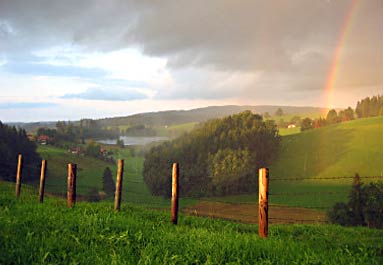This original column is provided free for one-time use with author credit at the end. It may be used for background with author credit. Copyright applies.
#56 FOR IMMEDIATE RELEASE: October 2, 2008
Sellers: Sticking on price keeps you stuck
By Curtis Seltzer
BLUE GRASS, Va.—I’m trying to figure something out: With rural property showing for-sale signs rusting in place, why haven’t sellers lowered asking prices and offered financing?
I spent several hours this weekend looking at rural listings around the country. Thousands are advertised, with many of each type in the same place at about the same price.
Few sellers appear to have come off their original asking prices during the last six months. In most areas, sales seem slow. Suburban sellers have cut their prices by 25 percent or more. So why aren’t rural land sellers doing the same?
First, rural sellers may not have as urgent a need to sell. Turnover in rural property is lower than in suburbs where homeowners are subject to job transfers and financial volatility. Rural sellers are often able to wait longer.
Second, sellers in a weakening market are inclined to imprison their asking prices with backward-looking expectations. Since prices and sales were strong a year or two ago, therefore, seller reasoning goes, they should be strong now (even if they’re not).
I’ve never had much luck in hoping better times into existence. My experience is that markets produce prices, not wish-fulfillment.
Third, sellers cling to forward-looking inflation dreams. Prices, they hope, will go higher. Hold tight, they tell themselves, prices go up…eventually. Which is generally true…eventually.
Fourth, sellers hold to high asking prices in a falling market to avert loss. MIT economist David Genesove and Columbia University economist Christopher Mayer found that Boston condo owners faced with a real loss (not just less profit) stuck with higher asking prices. This produced a little more in sales price, but involved the costs of holding the property longer.
Dan Ariely, author of Predictably Irrational and James B. Duke Professor of Behavioral Economics at Duke University, explains sellers pricing above market in two other ways. Once we own something, he told me, we “endow” it with more value than it’s worth. And when we “customize” real estate we think it’s better than similar properties, and should, therefore, be priced higher. These behaviors are understandable, but not rational, he said. (www.predictablyirrational.com) .
All of these factors encourage sellers to stick on unrealistic asking prices that won’t move their properties. And once anchored into that price, sellers feel they’re losing money with each reduction. In truth, they’re not losing anything. It isn’t there to be lost.
A seller usually sets an asking price by pegging it to recent sale prices of comparable properties. But a comp analysis can cement a seller’s asking price into an outdated, overpriced market. It will estimate past worth, not present value. It’s a rationale for not selling.
When a seller prices his property at $250,000 based on comps in a weakening market, a buyer won’t look at it because it’s anchored above the $150,000 he perceives to be its current worth. The buyer reasons that it’s not even worth making an offer. The buyer is wrong. Low offers educate sellers. Three no-budge offers at $150,000 are a shriek of reality, not a subtle signal.
This buyer also sees properties listed at $150,000 as overpriced. So nothing happens.
Buyers in a buyer’s market buy the properties re-priced at the new wholesale, not the old retail. When a dozen identical lots are each priced at $50,000, the first seller to drop to $40,000 will be the first to sell.
In today’s market, a must-sell-soon seller should use a comp-based appraisal value as a top line from which he drops to a get-it-sold asking price. If you need to sell today, you need to price below your comps-based “market” value.
Buyer expectations -- not appraisal values -- determine sale price in an overvalued market.
Prices are too high in many rural markets—especially for timberland, farmland and money-gobbling hobby farms.
Over the long term, all have appreciated steadily. That will continue because of population growth if nothing else. But this genuine, long-term rise in values was shot up with growth hormone for the last four or five years. Today’s asking prices are inflated beyond what many of these properties are worth today.
Much of this has to do with sellers pricing timberland and cropland at second-home value. Many rural sellers also seem to assume that hunters are rich idiots.
Many rural prices today are about what they were a year or two ago. They should be lower by 20 to 30 percent if a seller wants to sell. If a seller doesn’t need to sell, I’d advise pulling the property off the market for a while.
A seller has to set an asking price in a buyer’s market based, first, on what he needs to net from a sale.
Figure the amount you need to pay off your loan, closing costs and taxes (transaction taxes and income tax, both state and federal). Then figure the cash you have in the property—down payment and repaid principal, plus capital improvements. Then determine a reasonable profit on your cash. Price it there if you need to sell.
Or price it a little higher if you can seller-finance, which is a big help to a buyer and a cheaper alternative than institutional lenders.
If your calculations show that you’re going to lose money on a price-discounted sale, you have to guess whether you’re better off losing a known amount soon or holding in hope of a higher price at some unknown future point. It’s often true in down markets that the costs of holding outweigh the net gain from the hoped-for, higher future selling price.
To hold for a higher price, or to sell now at a lower price—that’s the seller’s question. Try this exercise. Assume a cut in asking price produces a sale that’s 30 percent less. Then project your costs of holding for 18 months at the current asking price and a sale for only five percent less. Which nets you the most dollars? Which produces the least amount of heartache?
Bad news rarely gets better by not reading the paper.
If it doesn’t pay to hold, then don’t. Cut the price. Get it over with. And move along.
Curtis Seltzer, land consultant, is the author of How To Be A DIRT-SMART Buyer of Country Property at www.curtis-seltzer.com. He holds a Class A residential contractor’s license in Virginia and has lived in a now 90-year-old farmhouse for 25 years.
Contact: Curtis Seltzer, Ph.D.
Land Consultant
1467 Wimer Mountain Road
Blue Grass, VA 24413-2307
540-474-3297
curtisseltzer@htcnet.org
www.curtis-seltzer.com
This original column is provided free for one-time use with author credit at the end. It may be used for background with author credit. Copyright applies.
.
|









